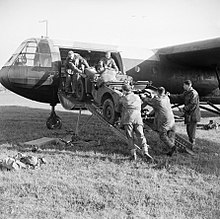Airspeed Horsa
| Airspeed AS.51 Horsa | |
|---|---|

|
|
| Type: | Glider |
| Design country: | |
| Manufacturer: | |
| First flight: |
September 12, 1941 |
| Commissioning: |
1942 |
| Production time: |
1941 to 1945 |
| Number of pieces: |
approx 3800 |
The Airspeed AS.51 Horsa was an aircraft manufacturer Airspeed Ltd. British glider built for the transport of troops during World War II . The aircraft was named after the legendary Anglo-Saxon warrior Horsa . It was used to transport British and Allied troops .
history
The British construction of gliders was a reaction to the successful use of the German DFS-230 gliders, which had contributed significantly to the capture of the Belgian fort Eben-Emael in May 1940. The advantage over landings with parachutes was that the troops could be concentrated in a small area, while in parachute missions they landed mostly widely scattered.
With 25 seats (and two pilots), the Horsa was significantly larger than the American Waco CG-4A (with a maximum of 13 crew members) and the British General Aircraft Hotspur (with only eight crew members), which was only intended for training missions. The AS.51 could transport a Willys MB Jeep or a 6-pounder anti-tank gun instead of crews .
The further developed AS.58 Horsa Mk.II had a hinge-opening bow , a reinforced floor and two nose wheels to accommodate additional vehicles. On the Horsa Mk.II the tow rope was hooked into the nose of the aircraft, while on the Mk.I it was attached to both wings.
Usage history

The Horsa had one of its first combat missions on the night of November 19-20, 1942 during Operation Freshman in Norway, which failed due to the weather conditions .
Other Known Uses: On July 10, 1943, when 27 gliders were used to invade Sicily during Operation Husky . As a result, numerous Horsa were used in Operation Thursday , Operation Overlord in Normandy , Operation Dragoon , Operation Market Garden , Operation Repulse and Operation Varsity . The first troops to land in Normandy during the invasion did so with Horsa gliders to take the Pegasus Bridge and thus hinder the advance of the German reinforcements. On June 5, 2004, to mark the 60th anniversary of D-Day, the replica of a Horsa was unveiled at the site of the first landing near the Pegasus Bridge.
For the missions, the Horsa were towed by Short Stirling , Handley Page Halifax , Armstrong Whitworth Albemarle , Armstrong Whitworth Whitley or C-47 Dakota . The glider pilots usually came from the Glider Pilot Regiment , a part of the British Army Air Corps , but pilots from the Royal Air Force were occasionally used. The device was also used by the US Air Force .
Construction and construction
The Horsa was developed based on the specification X.26 / 40 and built from 1940. The first flight took place on September 12, 1941. The aircraft was designed as a shoulder- wing aircraft and, due to the lack of other materials and the concept of a loss-making device, built entirely of wood . It was one of the first cargo gliders with a nose wheel landing gear for takeoff. During use, this could be thrown off and then land on a lower hull runner . The wings were equipped with very large pneumatically controlled landing flaps and air brakes , with which the aircraft could quickly descend steeply in order to be able to land in difficult terrain. The large cargo door was on the left. The stern could be thrown off to make it easier to get out.
The Horsa was considered robust and very maneuverable for a glider. Production took place at Airspeed and at contract companies, which included Austin Motors and the furniture manufacturer Harris Lebus. A total of around 3800 copies were built (the figures vary between 3655 and 5000). The specification required that the aircraft should be built in individual subsections in order to distribute production to different locations and thus minimize the loss in the event of a German attack on individual manufacturers.
Technical specifications
| Parameter | Data |
|---|---|
| crew | 2 |
| Passengers | 25th |
| length | 20.40 m |
| span | 26.80 m |
| height | 6.40 m |
| Wing area | 106.7 m² |
| Empty mass | 3400 kg |
| Takeoff mass | 6920 kg |
| Top speed | in tow: 204 km / h, gliding: 160 km / h |
See also
Web links


